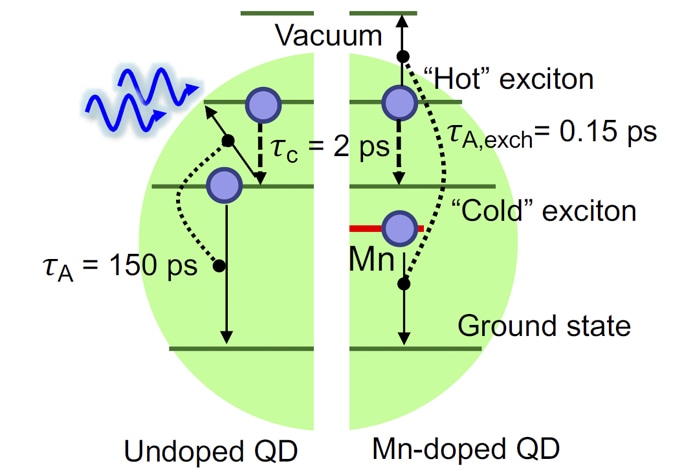Oct 9 2019
Researchers from Los Alamos National Laboratory have prepared magnetically doped quantum dots that can capture the kinetic energy of electrons produced by ultraviolet light before it is released as heat.
 Doping a quantum dot with manganese (right half of graphic) speeds the capture of energy from a hot electron to 0.15 picoseconds, outpacing losses to phonons in the crystal lattice. (Image credit: Los Alamos National Laboratory)
Doping a quantum dot with manganese (right half of graphic) speeds the capture of energy from a hot electron to 0.15 picoseconds, outpacing losses to phonons in the crystal lattice. (Image credit: Los Alamos National Laboratory)
This discovery can potentially enable novel, highly-efficient solar cells, light detectors, photocathodes and light-driven chemical reactions.
Victor Klimov, Lead Researcher, Quantum Dot Project, Los Alamos National Laboratory
In typical solar cells, more solar energy is released as heat due to the lack of effective methods to capture the kinetic energy of “hot” electrons produced by photons in the green to ultraviolet region of the light spectrum of sun.
This is because hot electrons lose their energy very rapidly owing to interactions with crystal lattice that the devices are made of, which results in vibrations called phonons. This process generally takes place within a few picoseconds (trillionths of a second).
Earlier attempts to capture hot-carrier energy have utilized the transfer of kinetic energy from the energetic hot electron to a static, low-energy electron. As a result, the electron is excited to a current-conducting state.
This effect, called carrier multiplication, increases the number of electrons to two times, providing the photocurrent that can be used for improving the performance of solar cells. However, in a majority of the traditional materials, the energy losses to phonons exceed the energy gains of carrier multiplication.
In the study reported in Nature Nanotechnology on October 7th, 2019, scientists show that adding magnetic ions into quantum dots could significantly increase useful, energy-producing interactions so that they become quicker than wasteful phonon scattering.
To execute these concepts, the scientists created manganese-doped quantum dots based on cadmium selenide.
The photon absorbed by the cadmium selenide quantum dot creates an electron-hole pair, or an exciton. This exciton is quickly trapped by the dopant creating an excited state that stores energy much like a compressed spring.
Victor Klimov, Lead Researcher, Quantum Dot Project, Los Alamos National Laboratory
Klimov continued, “When the second photon is absorbed by the quantum dot, the stored energy is released and transferred to the newly created exciton promoting it to a higher-energy state. The energy release by the manganese ion is accompanied by the flip of its magnetic moment, known as spin. Hence this process is termed spin-exchange Auger energy transfer.”
An interesting observation of LANL researchers was the very short time scale of the spin-exchange Auger interactions—about one-tenth of a picosecond. Researchers were surprised by these interactions that were quicker than phonon emissions, which were normally thought to be the quickest process in semiconductor materials.
To confirm that the new effect could excel phonon-assisted cooling, LANL scientists showed that properly designed magnetically doped quantum dots enabled them to extract a hot electron produced by an ultraviolet photon before its energy is lost toward heating the crystal lattice.
These paradigm-shifting results will pave the way for inspiring opportunities to utilize spin-exchange Auger processes in state-of-the-art schemes for improving solar cell performance or driving rare photochemical reactions. Exciting opportunities are also visualized in the fields of high-speed, high-sensitivity light detection and new types of light-driven electron sources.
This study was supported by the Solar Photochemistry Program of the Chemical Sciences, Biosciences and Geosciences Division, Office of Basic Energy Sciences, Office of Science, U.S. Department of Energy.